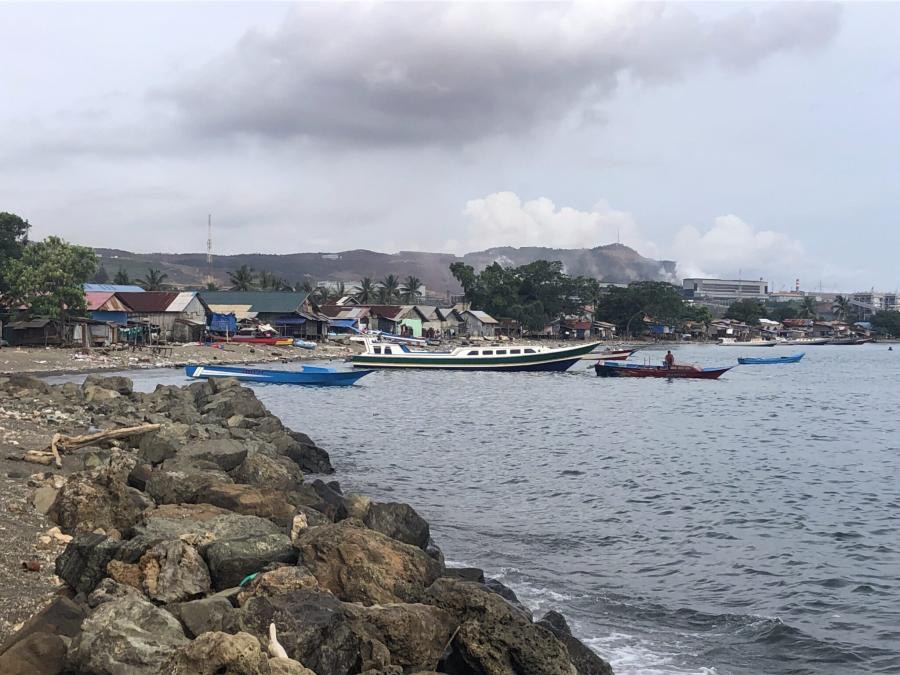In the past decade, tourism encouraged by the Indonesian government, the World Bank, international corporations and local entrepreneurs has become important on the famed isle of Bali. What are the effects of an annual onslaught of nearly a half million tourists on the island ecosystem already inhabited by over two million Balinese? How do the Balinese people respond to their international visitors? Can a culture which has adapted so creatively to former religious, economic, political and artistic challenges thrive or even survive? What, in short, is in store for future generations of Balinese?
ECOSYSTEMIC DESTRUCTION?
Irrigated rice fields are the main feature of agricultural life for the Balinese. These fields (sawah) depend on the regular flow of water through an elaborate irrigation system organized by "watershed societies" (subak). Irrigation is ordered through adherence to calendrical cycles initiated by ritual observances at the watershed temples. This agricultural system requires intensive labor, accurately regulating the water supplies and maintaining the dikes, canals, fields and terraces. Well-organized social groups are both a cause and effect in such a system.
Tourists and tourism have not had much effect on Balinese rice farming, for three reasons:
* Tourists view and admire the lush green of the rice fields from roadways, but rarely interfere in the process itself.
* Balinese view growing and harvesting rice as a valued vocation and have continued to grow rice even when other jobs have been secured. Students return from the university and clerks leave their offices during the village rice harvest in order to participate in the process. One Balinese doctor told me,
To be sure Bali will continue to be really Balinese, we must nourish our roots - at the temples, the villages, and in the rice fields. So I take my vacation at the time of the harvest. My whole family joins in bringing in the rice sheaves.
* Rice-growing areas have, in part, been protected from touristic exploitation by government regulations limiting hotels to certain zones, primarily along the coastal plain of southern Bali. The Balinese establish their spatial and personal orientation between the mountainward or upstream heights of the gods (kedja) and the oceanward or downstream place of demons (kelod). In between is the proper human habitation. This area of steep hillsides is transformed into rice terraces, house and temple compounds, and groves of coconut or banana trees. It is "home" to the Balinese, as the cold, barren mountain heights (extending up beyond 3,000 meters) and the wave-pounded, coral-strewn coast cannot be.
Tourists are thus welcome to use the beaches, swimming in the salt water which the Balinese view as a place of demonic power, and into which the ashes of their cremated relatives are deposited ceremonially. The Indonesian government, with World Bank consultants, has encouraged the development of hotels along the coast, but no new ones are to be taller than palm trees. Hotel developments in the interior villages, however, have been forbidden. Despite many pressures, largely from non-Balinese, villages and farms abutting rice land have not become hotel sites.
Tourists have not yet destroyed the central economic and agricultural activity of the Balinese, although to be sure, there have been and continue to be many threats to rice farming. While hotels are not allowed in the villages, commercial shops, restaurants and other tourist-traps are permitted. Some formerly productive fields have been taken out of rice production, and many Balinese have sold their land to "developers." The price of land along major tourist routes, such as in the villages of Mas or Batubulan, has sky-rocketed in the past decade. Farmers wishing to expand their fields could not hope to purchase such land, and owners often think it is more attractive to sell off to an "art shop" than to plant rice.
Another threat to the ecosystem comes from the destruction of Balinese coral reefs as the coral is used for building roads and making concrete. The coral reefs traditionally broke up the surf, but now these reefs have been hauled away. Pollution and scavengers prevent new ones from replacing them. The effect of a severe storm is likely to be devastating for the ecosystem as well as the nearby inhabitants. The effect on fish, mollusks and the beach itself without the protection of coral reefs remains largely unknown, but is sure to be a negative.
THE CHALLENGE TO BALINESE SYMBOL SYSTEMS, ETHICS AND ART
"Everyday" Balinese life is forged by social responsibilities to numerous groups and by ritual observance, preeminently at frequent temple ceremonies, but daily in small acts of piety such as placing an offering at a corner of a residential courtyard, or by wearing a flower over an ear, following the purifying performance of ablutions and prayers. How has tourism affected this "everyday" life?
First, some of the ceremonies performed for tourists have been "edited" from among the rich diversity of Balinese music, drama and dance, and have become boring to villagers. A performance of the confrontation between Rangda (the Destructive Witch) and Barong (the Benevolent Bestial Demon) was scheduled during the 1970s on Tuesdays, Thursdays and Saturdays in the village of Batubulan. Tourists arrived by taxi and bus, and were charged an admission fee to enter the "theatre" and watch the actors, hear the music and follow the printed program "libretto" for about an hour. Only villagers who were responsible for the production were present; in earlier years children and spectators had watched from the periphery, witnessing the spectacle.
Rangda and Barong have enormous exorcising power when dancing in a "real" situation - at night, when accompanied by trance experiences, their presence is believed to cleanse a village of illness or other destructive forces. But in Batubulan the symbolic power was undermined by too-frequent repetition, and Rangda and Barong were treated like a tired re-run. Such desacralization is a wide phenomenon, also seen in the case of other rituals changed for tourist consumption, such as the Kejak or "Monkey Dance;" and a welcoming dance for divine spirits, now performed at the airport to welcome government officials or other celebrities.
Second, the presence of foreign "guests" makes all the Balinese into potential "hosts," and many are turned toward sharp entrepreneurial practices. They are beset with "deals" from every nation. These range from the billion-rupiah transactions for land use rights, engineered by Japanese generals, Indonesian-Chinese merchants, or international hotel chains, to the requests for prostitutes by travelling Japanese businessmen, or the search for "good grass" by Euro-American "hippies." On the streets near hotels and on the beaches, young Balinese have learned enough English, Japanese, German or French to entice customers into shops, or to bargain over carvings or batiks. Guides compete fiercely for customers at airports and hotels, then take tourists on a kickback-laden trip to certain shops and "historic" sites.
In my experience, relatively few guides were accurate historians or ethnographers, and many imparted considerable misinformation about Ball. At one site called The Elephant Cave, for example, guides told tourists that it was so named for the herds of wild elephants that roamed Ball - a faunal inaccuracy - rather than for the elephant-faced god of Hinduism, Ganesa, who is considered the divine benefactor of the shrine.
Commercial opportunities to exploit tourists are vigorously pursued by many Balinese, but if is anathema to their traditional Bali-Hindu ethical codes to mistreat other humans, as their religious teachers frequently stress. Nonetheless, it is a temptation to fleece an unknown stranger, whether on Bourbon Street or on a Balinese beach; a temptation many islanders have not resisted. According to the Hindu understanding of Karma, such action will be punished by a more bestial incarnation.
Third, the performance of Balinese art for commercial purposes may eventually alter its form. Whether this transformation will also erode quality, as in the cheaply made "airport art" carvings found throughout Asia, remains to be seen, but one example is illustrative of another response. In the village of Sesetan lives a musical impresario, Nyoman Rembang, a teacher at the provincial music conservatory. He revitalized the local orchestra, rehearsing with them regularly until ready for public performances. Then the Sesetan gamelan orchestra, called Gon Duta Irama, was contracted to go not only to other Balinese villages and temples that wanted a polished troupe of musicians and dancers, but also to hotels and other tourist performances. They travelled by truck, in costume, to the beach hotels or the airport with their instruments, proud to be on stage and receiving payment for performing. The funds were used to build a new pavilion and temple at the village center.
This emphasis on musical and dance troupes performing for tourists has, to date, been a source of Improved artistic quality in Sesetan, as new costumes and gamelan instruments have been purchased, and time and energy have been devoted to rehearsals. Throughout the Island, schools, academies and institutes for the arts teach young Balinese to learn and refine their arts. In short, Balinese are being paid by a new set of international patrons called tourists to do what they are culturally skilled at doing - creating and performing art.
To an extent the tourist market will surely alter and modify this art, perhaps for the worse, but some safeguards do exist. Indigenous critics seek artistic perfection in the work they create, and an island-wide provincial group of critics now licenses only competent performers as eligible to entertain tourists. For example, the musical educator of Sesetan, Nyoman Rembang, is a member of this group of critics. He observes and evaluates dance and music groups that seek to perform publicly. They must have official sanction from him and his colleagues to do so. In this way the quality of some Balinese art forms is being conserved, maintained and even strengthened in the face of the potential cheapening by touristic tastes.
PREVENTION AND AMELIORATION OF TOURISTIC PROBLEMS
The Indonesian Department of Tourism and its Balinese office have a central role in predicting, recognizing and treating the challenges created by the economically profitable, but culturally threatening, tourism of this high-technology and travel-minded generation. The Bali Department of Tourism has begun to take the lead in serving as a "cultural conservator," working with other government offices, as well as university researchers, religious leaders and the tourist industry, but this role needs constant encouragement by the central government, as well as the Governor of Bali. Since tourism is viewed by Indonesian officials as a vital source of international currency, the Balinese have real leverage in fighting for their cultural health, which after all is the raison d'etre for the tourist industry. But the Department of Tourism needs the top-down authorization to make and enforce hard decisions which might counter certain interest groups and their short-term gains. The Balinese provincial leaders should insist that a requirement for an honest "cultural impact study" for proposed developments in each of the governmental agencies and by the private sector will be instituted. A panel of Indonesian leaders could then adjudicate the decisions, based on the goals of a "master plan" already undertaken for Bali by the World Bank.
At the same time, tourists can be educated as they arrive and stay in Bali. Visitor centers, mini-museums, slide-tape programs and films in transit could alert tourists about what to expect and why, how to behave, and what actions will show honor to the Balinese.
Educating, testing and licensing of guides, tour operators, and local performing groups would likewise strengthen the ability of Balinese to understand their role in promoting an enduring culture for coming generations.
Is Bali unique in its relationship to tourism? As in so many other ways, assuredly so. But in offering a potential both for future tourism and for its own cultural future, Bali may provide a model for other peoples as well.
Article copyright Cultural Survival, Inc.



